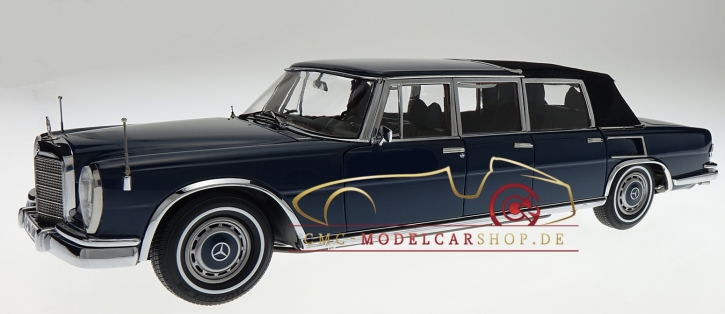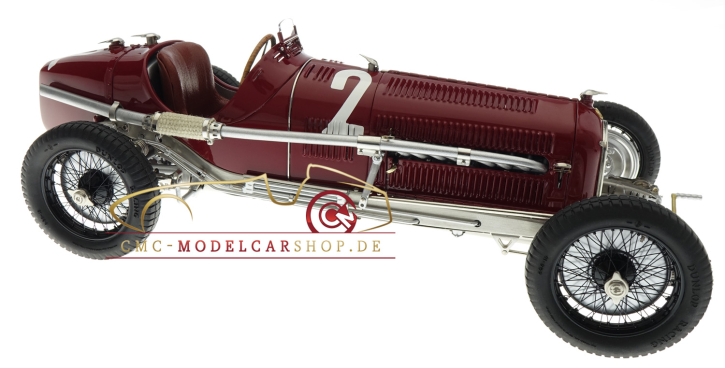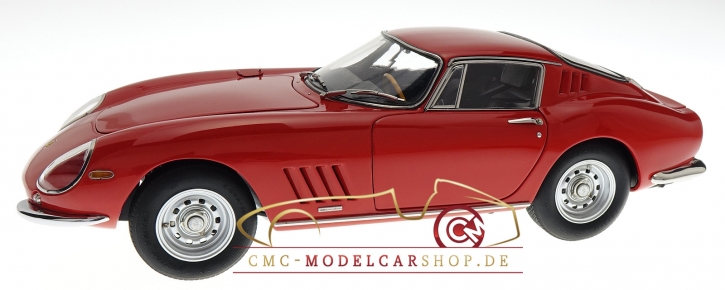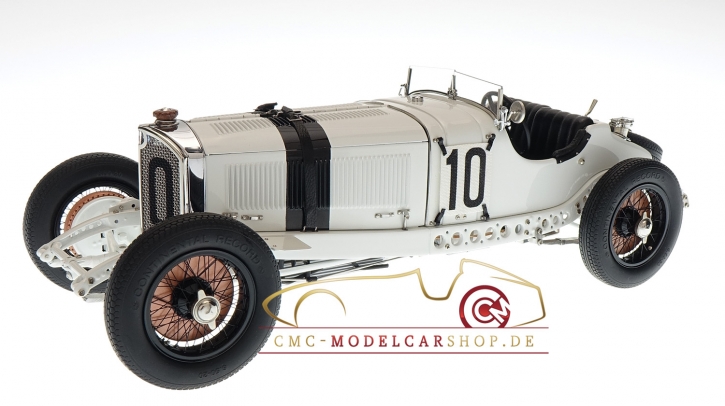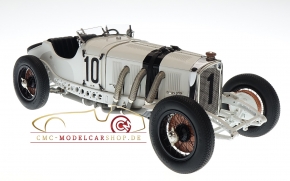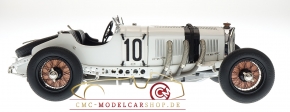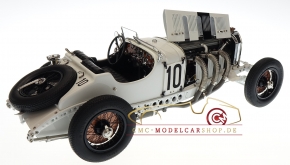399,00 EUR RRP 435,00 EUR you save 8.3% (36,00 EUR)
incl. 19 % VAT excl. shipping costs
delivery time: 3-7 Werktage
Product.Nr.: CMC M-188
product description
A masterpiece of architecture model:
CMC Mercedes-Benz SSKL, 1931 GP Germany, #10 Hans Stuck
CMC has already replicated Caracciola‘s winning car with starting number 8. This year we would like to pay tribute to the achievements made by Otto Merz and Hans Stuck at the German Grand Prix on July 19, 1931. With that in mind, CMC will develop and make available authentic detailed replicas of their SSKL racers in 1:18 scale.
CMC has already replicated Caracciola‘s winning car with starting number 8. This year we would like to pay tribute to the achievements made by Otto Merz and Hans Stuck at the German Grand Prix on July 19, 1931. With that in mind, CMC will develop and make available authentic detailed replicas of their SSKL racers in 1:18 scale.
Technical data of the CMC model:
- Model: Precision model hand-assembled
- Manufacturer: CMC GmbH, Classic Model Cars, Germany
- Scale: 1:18
- Item-No.: M-188
- Parts: more than 1,700
- Limited Edition: 800
Model details:
- Hand-crafted metal precision model built from more than 1700 parts
- Authentically and true to scale formed car body
- Originally reproduced lightweight steel frame
- Grille and rock guard in superior quality metal finish
- Split mid hinged bonnet with leather-belt fastenings
- Rear bonnet fastenings finished in metal
- Inline six cylinder complete with peripherical components, piping and cabling
- Exhausts finished in metal hosed flexible pipes
- Perfectly crafted wheels with alloy rims and by hand mounted stainless steel spokes and nipples, painted matte black
- Removable center lock wheel fasteners
- Spare wheel mounted with a locking handle, detachable
- Leaf springs finished in metal on front and rear axle
- Hinged fuel filler finished in stainless steel
- Moveable throttle-/ignition lever mounted at the steering wheel
- Authentic replication of the cockpit and its gauges
- Both seats covered with real leather
- Moveable windscreen for both driver and co-driver
- Brake drums in the authentic copper design with cooling fins
- Starting numbers at both sides authentically replicated as a clothed print
Description of the original vehicle:
From the mid to late 1920s and even in 1931, the world racing scene was largely dominated by one automotive marque: Mercedes-Benz, especially with its SSK/SSKL models that is empowered by the legendary 7.1 liter compressor.
The SSKL often went by the affectionate nickname of "White Elephant." On the one hand, this could be attributed to its seemingly unruly power and colossal size. On the other, it had much to do with the German racing livery that Rudolf Caracciola, Hans Stuck and Otto Merz had on their SSKLs and the plethora of honors they won in racing the SSKLs. Despite the global economic crisis and limited support from the Daimler-Benz factory in Stuttgart Untertürkheim, Rudolf Caracciola and his two teammates ma-naged to keep up their chins and brave through the hardships. In addition to his victory at the 1931 Mille Miglia, Caracciola finished first in the 1931 Grand Prix of Germany, whereas Otto Merz and Hans Stuck took a fifth and sixth places in the same race.
The race was held in two groups.
Group I was for vehicles over 1100 cc, which were to run 22 laps (22x 22.81 km), covering a total distance of 501.82 km.
Group II was for vehicles up to 1100 cc, which were to run 18 laps (18 x 22.81 km), equivalent to a total distance of 410.58 km.
All racing cars started off at the same time. It was assumed that the two groups would finish the race around the same time. To distinguish them visually for the pit crews and the spectators, Group I cars were marked with a wide black horizontal stripe over the hood, whereas Group II cars used a wide white stripe instead. Since many of the small-displacement race cars were native to Germany and had a white-finished body, the white stripes on them were outlined in a black color additionally.
The Mercedes team set itself up at the Nürburgring two weeks earlier. Before long, it buckled down to test driving under the direction of Alfred Neubauer. Apart from the practices of racing, the training program also included how to change tires with a newly-developed jack and manage the refueling process, etc. This type of training went so far that together with his mechanic, Caracciola was able to complete a tire change in a minute and 10 seconds. His teammates were not much slower.
48 entrants of Groups I and II from 10 different nations were ready to start off on the rainy day of July 19, 1931. Mercedes fielded its SSK and weight-reduced SSKL vehicles, and the latter were primarily saved for its famous pilots like Caracciola, Branditsch, Merz, Stuck, and Spandel. The main rivals were from the other well-known marques, such as Bugatti, Maserati and Alfa Romeo, which provided much lighter and better engineed vehicles to their internationally-renowned pilots, such as Chiron, Varzi, Fagioli or Nuvolari.
The race proved to be a clear win for Rudolf Caracciola, who dominated from the start to the finish. Only after the 13th lap, when it stopped raining, was Louis Chiron able to start undercutting Caracciola's lead in a Bugatti. But it was too late, for Caracciola was so far ahead. The other two Mercedes pilots, Otto Merz with starting number 12 and Hans Stuck with starting number 10, drove a consistent and canculated race to take the respectable fifth and sixth places.
The SSKL often went by the affectionate nickname of "White Elephant." On the one hand, this could be attributed to its seemingly unruly power and colossal size. On the other, it had much to do with the German racing livery that Rudolf Caracciola, Hans Stuck and Otto Merz had on their SSKLs and the plethora of honors they won in racing the SSKLs. Despite the global economic crisis and limited support from the Daimler-Benz factory in Stuttgart Untertürkheim, Rudolf Caracciola and his two teammates ma-naged to keep up their chins and brave through the hardships. In addition to his victory at the 1931 Mille Miglia, Caracciola finished first in the 1931 Grand Prix of Germany, whereas Otto Merz and Hans Stuck took a fifth and sixth places in the same race.
The race was held in two groups.
Group I was for vehicles over 1100 cc, which were to run 22 laps (22x 22.81 km), covering a total distance of 501.82 km.
Group II was for vehicles up to 1100 cc, which were to run 18 laps (18 x 22.81 km), equivalent to a total distance of 410.58 km.
All racing cars started off at the same time. It was assumed that the two groups would finish the race around the same time. To distinguish them visually for the pit crews and the spectators, Group I cars were marked with a wide black horizontal stripe over the hood, whereas Group II cars used a wide white stripe instead. Since many of the small-displacement race cars were native to Germany and had a white-finished body, the white stripes on them were outlined in a black color additionally.
The Mercedes team set itself up at the Nürburgring two weeks earlier. Before long, it buckled down to test driving under the direction of Alfred Neubauer. Apart from the practices of racing, the training program also included how to change tires with a newly-developed jack and manage the refueling process, etc. This type of training went so far that together with his mechanic, Caracciola was able to complete a tire change in a minute and 10 seconds. His teammates were not much slower.
48 entrants of Groups I and II from 10 different nations were ready to start off on the rainy day of July 19, 1931. Mercedes fielded its SSK and weight-reduced SSKL vehicles, and the latter were primarily saved for its famous pilots like Caracciola, Branditsch, Merz, Stuck, and Spandel. The main rivals were from the other well-known marques, such as Bugatti, Maserati and Alfa Romeo, which provided much lighter and better engineed vehicles to their internationally-renowned pilots, such as Chiron, Varzi, Fagioli or Nuvolari.
The race proved to be a clear win for Rudolf Caracciola, who dominated from the start to the finish. Only after the 13th lap, when it stopped raining, was Louis Chiron able to start undercutting Caracciola's lead in a Bugatti. But it was too late, for Caracciola was so far ahead. The other two Mercedes pilots, Otto Merz with starting number 12 and Hans Stuck with starting number 10, drove a consistent and canculated race to take the respectable fifth and sixth places.
CMC Legal Disclaimer
The use of racing team and/or driver names, symbols, starting numbers, and/or descriptions is solely for reference purposes. Unless otherwise stated, it does not imply that the CMC scale model is a product of any of these racing teams/drivers or endorsed by any of them.
Technical data of the original vehicle:
- Six cylinder in-line-engine with overhead camshaft
- Compressor that can be activated when required
- Output without compressor: 240 hp at 3.300 rpm
- Output with activated compressor: 300 hp at 3.300 rpm
- Displacement: 7,056 ccm
- Top speed: 235 km/h
- Wheel base: 2,950 mm
- Total length: 4,250 mm
- Track front: 1,470 mm
- Track rear: 1,460 mm
More Mercedes-Benz from CMC Classic Model Cars













